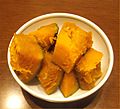Kabocha facts for kids
Kabocha (say "kuh-BOH-chuh") is a special kind of winter squash. It's a Japanese type of a large squash species called Cucurbita maxima. People in North America often call it kabocha squash or Japanese pumpkin. In Japan, the word "kabocha" can mean this squash, a Western pumpkin, or other kinds of squash.
Many kabocha squashes you find are kuri kabocha. This type was created from another squash called seiyo kabocha. Some common types of kabocha include Ajihei, Cutie, Ebisu, and Miyako.
Contents
What Kabocha Looks Like
Kabocha has a tough, bumpy skin that is usually deep green. It looks like a short, wide pumpkin. The skin might have some light green or white stripes. Inside, the flesh is a bright yellow-orange color.
It is similar to a buttercup squash. But kabocha does not have the small "cup" shape at its bottom end. Most kabocha squashes weigh about two to three pounds. However, some larger ones can weigh up to eight pounds!
How People Use Kabocha
Kabocha tastes very sweet, even sweeter than butternut squash. Its texture and flavor are like a mix of pumpkin and sweet potato. Some people say it tastes like Russet potatoes or chestnuts.
You can eat the skin, but some cooks peel it. Peeling can make it cook faster or suit different tastes. Kabocha is often used in side dishes and soups. It can also replace potatoes or other squashes in recipes.
To cook it, you can cut the squash in half and remove the seeds. Then, cut it into wedges. With a little cooking oil and seasoning, you can bake it in the oven. You can also steam cut halves in a pressure cooker for about 15–20 minutes. Another way is to bake a whole, uncut kabocha slowly in a convection oven. This makes the whole squash soft, including the skin.
Kabocha is available all year. But it tastes best in late summer and early fall. It is grown in many places around the world. These include Japan, South Korea, Thailand, parts of the United States, Mexico, and New Zealand. Much of the kabocha grown in California, Colorado, Tonga, and New Zealand is sent to Japan.
Kabocha in Japan
In Japan, kabocha is a popular ingredient in tempura, which are deep-fried vegetables. It is also used to make soups and croquettes, which are small fried patties. People also use it in desserts like pies, pudding, and ice cream.
Kabocha in Korea
In Korea, kabocha is called danhobak (단호박). It is often used to make hobak-juk (pumpkin porridge).
Kabocha in Thailand
In Thailand, kabocha is called Fak thong (ฟักทอง). It is used in many traditional Thai desserts and main dishes. Kabocha is also used in Jamaican chicken foot soup.
Kabocha Nutrition
This squash is very healthy! It has a lot of beta carotene, which is good for your eyesight. It also contains iron, vitamin C, and potassium. You can find smaller amounts of calcium, folic acid, and some B vitamins in it too.
How to Tell if Kabocha is Ripe
When kabocha is first picked, it is still developing. So, being "fresh" is not the most important thing. For the best flavor, it needs to become fully ripe.
First, the kabocha should ripen in a warm place (about 77°F or 25°C) for 13 days. This helps turn some of its starch into sugar. Then, it is moved to a cooler place (about 50°F or 10°C) and stored for about a month. This helps it get even more carbohydrates. This process turns a bland, dry kabocha into a smooth, sweet one.
A fully ripe and delicious kabocha will have reddish-yellow flesh. Its skin will be hard, and its stem will be dry and corky. It reaches its best ripeness about 1.5 to 3 months after it is picked.
History of Squashes
All types of squashes first came from a region called Mesoamerica. This area includes parts of modern-day Mexico and Central America. In 1997, new information showed that squashes were first grown by people about 8,000 to 10,000 years ago. This was thousands of years earlier than people thought before. It was even 4,000 years before people started growing maize (corn) and beans in Mesoamerica.
Later research in the 21st century suggests that people in eastern North America also started growing their own squashes. They also grew sunflowers, marsh elder, and chenopod plants.
Portuguese sailors brought kabocha to Japan in 1541. They carried it with them from Cambodia. The Portuguese name for the squash was Camboja abóbora. The Japanese shortened this to kabocha. Another idea is that the name came from the Portuguese word cabaça, meaning "gourd."
In Japan, kabocha is written using Kanji characters as 南瓜. This literally means "southern melon." Sometimes, it is also called 南京瓜, which means "Nanking melon." In China, this term is used for many kinds of squashes with hard skin and thick flesh, not just kabochas.
Images for kids





















